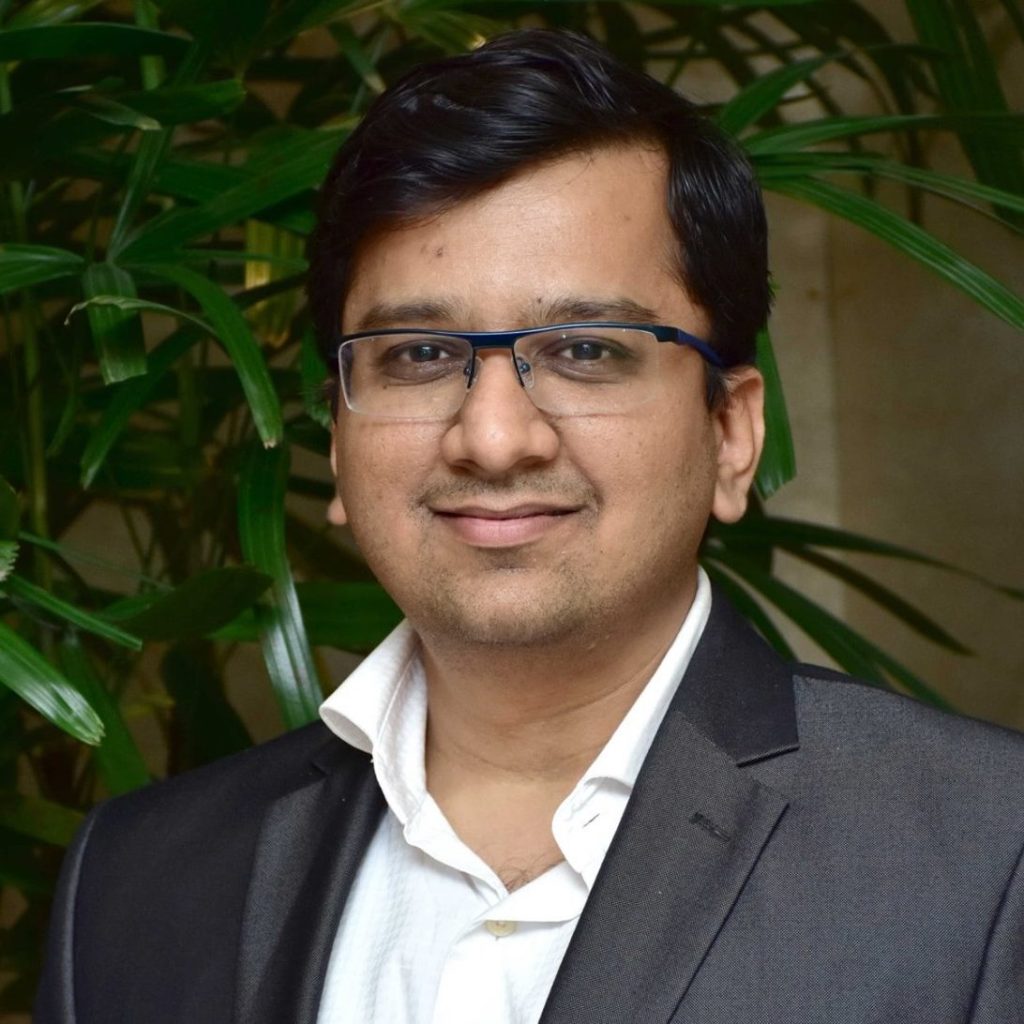Our conversation with Punit helped us learn the ball-game of marketing through customer education and how a diverse work background makes one an all-around learner.

Having the perfect strategy to market any product/service, Punit has honed his skills from his deep interests in marketing. His marketing skills have undoubtedly given the best results no matter what industry he was in.
Punit has worked in industries like additives, travel and tourism, airlines, and now excelling in the Fintech world. Today, he is the Vice President –Marketing and Investor Education at the Association of Mutual Funds in India (AMFI). Formerly, he held the designation of the Senior Marketing Manager at ICICI Bank. Punit pursued his Masters in Marketing from Narsee Monjee Institute of Management Studies in 2003.
His experience from diverse backgrounds was itself enough to urge us to dive into a conversation with him. Keep scrolling to know how fascinating his journey was!
The Key to Diverse Learning:
Punit has interests in multiple sectors like banking and finance, global logistics, chemical industry, and airlines. His inclination towards multiple streams has made him an all-around learner. He mentions that eager and curious learning has helped him to make each endeavor a success. From selling chemicals as his first job to understanding global shipping logistics, Punit showcases his hunger for constant learning. He also mentions his current field of Fintech which he states as dynamic. Talking to your seniors, colleagues, and getting immersed in the industry are the factors which he gives credit to. He says,
“I consider myself a generalist and not a specialist. This perspective has helped me work on a wider range of sectors.”
What inspired Punit to take up marketing?
He frames,
“As a kid, I was immensely fascinated by adverts on TV. There was a time when I used to recite and enact them in front of my family during childhood.”
Besides, during college Punit also participated in ad contests. These were to create funny ads for specific products. He and his team also won numerous prizes in these contests. All these factors led him to figure out his deep inclination towards marketing and pursue it as a career.
The perks of being an avid traveler for Punit and his professional life:
Punit considers traveling as his personal hobby. At the same time, it has proved beneficial for his professional life. He shares that traveling, as his professional responsibility has made him curious and patient.
He frames,
“My experiences from traveling and meeting different people help me to understand the target audience better. It also supports making empathetic designs for my campaigns.”
The era of inclusive designs:
Punit agrees that the designs of platforms today are not inclusive of all types of audiences. For instance, for physically impaired individuals it is still difficult to access various platforms. The interfaces of the majority of websites or apps are not suitable for such kind of users. But he believes that as technology is evolving, designs will become more access-friendly. He states,
“Website developers see the larger set of audience and do what is convenient to majority users. Even in banking and finance, regulators are asking us to make the websites more inclusive. Over the coming years, I firmly believe that interfaces will be a lot more user-friendly for all segments of users.”

Major UX Improvisation and its Role in Combination with Marketing:
Punit says,
“According to me, one major UX improvisation which has heavily impacted is the ‘One-Click Experience’. One-click buying, one-click shortlisting, and one-click payments have shortened the journey. It has proved to make faster decisions at the customer’s end.”
When it comes to the balance between Marketing and UX, Punit believes it’s the UX that has the upper hand. It is important to consider what the user experiences while they are on the platform. If the UX gives a seamless experience throughout your touch-points, the conversion will be much easier. This will eventually lead to more customers as currently the way of approaching the audience is purely digital.
The secret behind selling a financial product:
Punit explains that unlike tangible products, financial products cannot be sold conventionally. Since there is no physical return for the financial product. He gives an example of a TV, where people can touch, experience, and can then buy it. But it’s not the same for a financial product where companies hold someone’s money for a long time. So the only factor that is crucial while selling such products is TRUST. He frames,
“All your marketing team has to do is generate TRUST. This will make the customer invest in your financial product. May it be mutual funds or any other financial product.”
Punit’s Successful Marketing Campaigns:
Punit shares that he has run multiple marketing campaigns for various companies. The majority of them gave remarkable responses from the audience. He shares his experiences from one of his successful marketing campaigns, ‘Mutual Funds Sahi Hai’. The aim of this campaign was to educate people and explain the benefits of investing in mutual funds. His team researched the behavior of people of various age segments
towards investing. It came to their notice that youngsters generally took the advice of their elders whether or not to invest in mutual funds. But these elders themselves weren’t aware of it. So they often gave a red signal for investing in mutual funds. To overcome this constraint, Punit and his team especially created adverts for the elder individuals. These adverts made them familiar with the cons and security of mutual funds. He says, “These ads were specially made for the elder segment of society. We
showed an elder person investing in mutual funds on behalf of his son. Then a mutual fund protagonist comes and shares how even he invested in them for his daughter. Like you try out new technology, try out these new methods of investing too.”
Investing: Where do Indians stand at it?
Punit explains that Indians are really good savers of money. Most of them save a large portion of their income. But where they lack is investing.
So although they are good savers, statistics show that they have been bad investors. He mentions the statistics as,
“There are about 75 crores bank accounts in the country. But we have only 2 crores mutual fund investors. There’s a tremendous difference between both. This gives a picture of how much more Indians need to be educated about investing.”
Further, he also shares that people often treat insurance as an investment. This is absolutely a wrong perspective. He believes insurance is purely a different thing. One has to understand that insurances and investments are two separate forms. Insurance mitigates risk, while investments help us multiply our assets. Moreover, he talks about ‘Unit-linked Insurance Plans’. These generally are insurance with a mutual fund-like product linked to it. But investing in them separately is more beneficial, he shares.
Simplifying a Financial Product:
In order to make an investor invest in a financial product, he/she needs to completely understand that product. Here, simplifying the financial products, schemes, and returns become crucial. Punit used versatile strategies to simplify the concept of mutual funds in a more relatable way. This is why the campaign was named ‘Mutual Funds Sahi Hai’. The term ‘Sahi Hai’ is quite colloquial and familiar to us. At the same time, capturing emotions play a crucial role. His campaign was advertised in 8 different languages. This made it easier for local people to understand. Besides, visuals give a huge contribution in explaining the mutual fund basics to the audience. Their website has around 50 videos, infographics, and photographs. He states,
“We used a lot of videos which explained mutual fund basics in regional language. Right from ‘What is a mutual fund?’ to ‘What is an exchange-traded fund?’”
Marketing in Rural India:
Punit believes a lot of things have to be considered while marketing. He realized this when he worked with ICICI Bank in rural areas. He shares instances where people were hesitant to give their money to the banks.
Secondly, people were not comfortable with a shiny bank having glass walls. They were accustomed to structures with normal shutters. So there, the rural landscapes had to be considered. Moreover, they had to communicate in the local language.
Impact of Technology Over Investment Decisions:
Punit firmly agrees that technology has already started impacting investment decisions. He gives the example of recent months, where a lot of new investors came on board.
“Platforms with good UI and UX have made it easier to understand more about the product and also invest in it.”
Also, advanced technologies like Artificial Intelligence and Machine Learning make the investment decisions simpler and take very little time to onboard a user.
The Timeline of Scope in Investments:
Investing greatly depends on recent outputs. When people say that the markets are giving good returns, more people invested in it. When markets were down, investors shifted to other investment options. Talking
about the recent covid times, he says,
“Although the markets have gone down in the last few months, people have stayed invested. This indicates a sense of maturity in investors.
An understanding of a fall is not always scary. In fact, it could also be a good opportunity.”
The importance of UX for businesses while setting up their digital platforms:
According to Punit, the UX of a platform is of great importance. He says,
“The UX will decide how much time a customer will spend time on your website or app. Let’s assume the customer stays for a long time. But will he find the content useful? Will he buy your product? All this will be decided by the UI/UX.”
The Evolution of Marketing Over the Years:
Punit talks about his strategies of marketing while working in rural areas at ICICI Bank. They used to run dairy farmer gatherings and distribute their sales brochures. His team used to visit the farmers and understand their dreams and aspirations. From one of the conversations with a farmer, they got the idea of launching the concept of ‘Cattle-loans’. Over which they made a film. Talking more about it he says,
“We made a film on a farmer having a brilliant daughter but no money for further education. Then we introduced our product of ‘Cattle-loans’. By which he buys cows, supplies milk to the dairy, and gets higher income. We ran this ad in around 300 villages and in different languages.”
Coming back to the current scenario, now we hardly get time to interact with our customers. Everything is digital, the customer is on the phone or in front of a screen. We just push our products and let them make their own decisions. So that is how ways of marketing have evolved over the years.
Rapid Fire Round:
We had a fun rapid fire round with Punit:
1) What is your Bible? Books or Blogs?
● Books
2) Which is the one book you would recommend to our readers?
● ‘Shiva’ by Amish Tripathi
3) Your go-to travel destination?
● For me, any place would be a pleasure to travel. But to name one, it would be Sikkim.
4) One childhood trait you still have and admire?
● The trait of making friends easily.
5) Are you a morning person or a night person?
● Morning person
6) Which is the first app you use every morning?
7) Videos or Podcasts?
● Videos
8) What is your favorite item to cook?
● Maggi
9) Gas stove or Microwave?
● Gas Stove
10) TV or OTT?
● OTT




